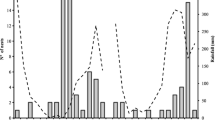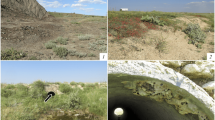Summary
Mischocyttarus immarginatus often nests in association withPolybia occidentalis in the dry forest of Costa Rica. The establishment of twoM. immarginatus nests near a nest ofP. occidentalis was observed. There is competition for nesting sites by foundresses ofMischocyttarus, characterized by intense agonistic encounters. At established nests, the queens spend most of their time on the nests, constructing and inspecting nests and cells. Workers spend most of their time away from the nests. Sometimes, the queen forces a worker to leave the nest.
I hypothesize thatP. occidentalis nests in areas, such as on buildings and spiny plants, to avoid nest destruction by browsers and grazers, whileM. immarginatus nests nearP. occidentalis as the result of predator pressure from visual predators, such as birds and lizards.
Zusammenfassung
Im Trochenwald von Costa Rica nistenMischocyttarus immarginatus undPolybia occidentalis oft nahe beisammen. Zweimal wurde beobachtet wieM. immarginatus ein Nest vonP. occidentalis gründete. NestgründendeM. immarginatus Königinen an potentiellen Nistorten heftig miteinander kämpften. Die Königinen verwenden den grössten Teil ihrer Zeit auf den fertigen Nesten mit Bauen und Inspizieren. Arbeiterinen halten sich meist entfernt vom Nest auf. Manchmal zwingte die Königin eine Arbeiterin das Nest zu verlassen.
Ich schlage vor, dassP. occidentalis an Häusern und stacheligen Pflanzen nistet, um Nestzerstörung durch weidende Grossäuger zu vermeiden.M. immarginatus, dagegen, nistet naheP. occidentalis, um sicher vor Nesträubern, wie Vögeln und Eidechsen, zu sein.
Similar content being viewed by others
References
Bequaert (J.), 1933. — The nearctic social wasps of the subfamily Polybiinae (Hymenoptera, Vespidae).Entomol. Amer., 13, 87–150.
Breed (M. D.) andGamboa (G. J.), 1977. — Behavioral control of workers by queens in a primitively eusocial hee.Science, 195, 694–696.
Janzen (D. H.), 1969. — Birds and the ant-acacia interaction in Central America with notes on birds and other myrmecophytes.Condor, 71, 240–256.
Jeanne (R. L.), 1970. — Chemical defense of brood by a social wasp.Science, 168, 1465–1466.—Jeanne (R. L.), 1972. Social biology of the neotropical waspMischocyttarus drewseni. Bull. Mus. Comp. Zool., 144, 63–150.
MacLaren (P. I. R.), 1950. — Bird ant nesting associations. ——Ibis,,92, 564–566.
Myers (J. R.), 1929. — The nesting together of birds, wasps, and ants.Proc. Entomol. Soc. London, 4, 80–90.
Rau (P.), 1933. — Jungle bees and wasps of Barro Colorado Island. édit., St. Louis, 324 p.
Richards (O. W.), 1945. — A review of the genusMischocyttarus De Saussure.Trans. Roy. Entomol. Soc. London, 95, 295–462.
Smith (N. G.), 1968. — The advantages of being parasitized.Nature, 219, 690–694.
Vesey-Fitzgerald (D.), 1938. — Social wasps (Hymen.: Vespidae) from Trinidad with a note on the genusTrypoxylon Latreille.Trans. Roy. Ent. Soc. London, 87, 181–191.
Wilson (E. O.), 1971. — The insect societies. Harvard University Press, édit., Cambridge, 548 p.
Windsor (D. M.), 1972. — Nesting association between two neotropical wasps (Hymenoptera, Vespidae).Biotropica, 4, 1–3.—Windsor (D. M.), 1976. Birds as predators on the brood ofPolybia wasps (Hymenoptera: Vespidae: Polistinae) in a Costa Rican deciduous forest.Biotropica, 8, 111–116.
Zikan (J. F.), 1935. — Die sozialen wespen der gattungMischocyttarus Sauss. nebst beschreibung von 27 neuen arten (Hymn., Vespidae).Arg. Inst. Biol. veget. 1, 143–203.
Author information
Authors and Affiliations
Rights and permissions
About this article
Cite this article
Gorton, R.E. Observations on the nesting behavior ofMischocyttarus immarginatus (Rich.) (Vespidae: Hymenoptera) in a dry forest in Costa Rica. Ins. Soc 25, 197–204 (1978). https://doi.org/10.1007/BF02224741
Received:
Accepted:
Issue Date:
DOI: https://doi.org/10.1007/BF02224741




